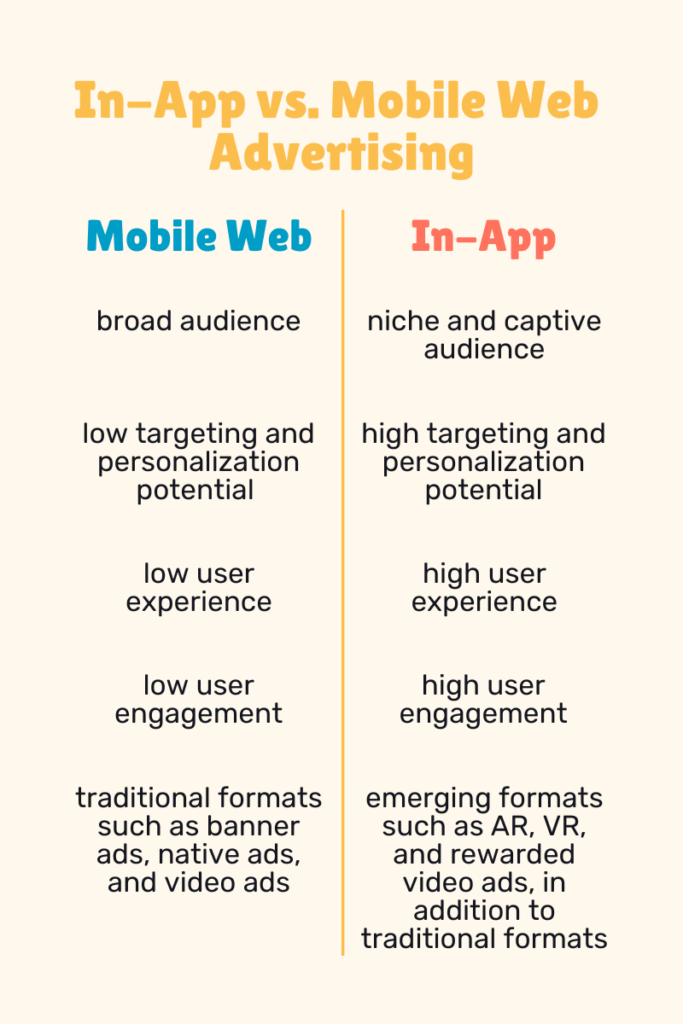Introduction
In this digital age, mobile applications are integral to our daily lives. The increase in in-app advertising reflects this truth, with total mobile in-app ad spending reaching nearly $77 billion – ten times the amount spent on mobile web ads.
In-app advertising, such as Offerwalls, can help enhance user experience and brand loyalty while monetizing the app. However, many developers make common mistakes in their app advertising strategies, which can hinder their success.
In this blog post, we’ll explore five of the most common app advertising mistakes and provide insights on how to avoid them.
Table of Contents
Mistake 1: Treating Mobile App Advertising the Same as Other Platforms
Multiplatform advertising is an effective solution for reaching intended audiences. Advertisers can repurpose ads for many platforms, including desktop or mobile web-based, mobile search, in-app, cross-app, location-based, and social media.
Understanding the preferences of each intended audience for each advertising platform and their technicalities is imperative.
Additionally, many developers assume they can employ the same mobile advertising strategies across each type. However, mobile users have different behaviors and expectations when they use various mobile channels.

Following Online Advertising Strategies
When creating a cross-device application, the developer should consider the unique characteristics of each platform. Rather than sticking to online advertising strategies, developers can focus on creating visually appealing ads compatible with various mobile devices and screen sizes.
While some tactics may overlap, mobile advertising requires a unique approach to optimize for changing user behavior and screen size. Strategies like banner ads or pop-ups, which may work well on desktops, can be ineffective or annoying for mobile users.
Additionally, optimizing loading times and ensuring a seamless user experience are critical factors for success in mobile advertising.
Ignoring Mobile App-Specific Optimization
Mobile app-specific optimization is essential for effective advertising in apps. However, there is often little differentiation between the two primary mobile channels: mobile web and mobile apps.
Compared to mobile web ads, in-app ads have a more engaged audience. Mobile apps have an increased ability to target and personalize in-app ads thanks to location, demographics, and app content data.
Technically, mobile apps are developed for a particular operating system, whereas mobile websites are delivered through smartphone browsers. With these differences in mind, developers can better utilize optimized ad formats such as Offerwalls or native ads, and experiment with new ad types such as augmented reality.
Mistake 2: Not Considering Ad Viewability
Ad viewability refers to whether users see an ad. Ignoring or ineffectively measuring ad viewability can lead to wasted ad spend and ineffective campaigns.
Both 42% of brands and 48% of agencies are concerned with challenges associated with measuring in-app advertisement viewability. Their concerns demonstrate the necessity for app developers and publishers to make their advertisements viewable to users.
So, how can ad viewability go wrong?
Poorly Designed User Interface
Advertisers must carefully consider the placement and technical delivery of their ads to maximize visibility and engagement. Poorly designed ad placements, including ads placed below the fold or in unnoticeable areas, can significantly impact viewability.
Developers can increase viewability by placing ads in prominent and visible locations within the app. Additionally, they should ensure the ad is fulfilling pixel and time requirements.
Lack of Responsive Design
In today’s multi-device world, ads must be responsive and adaptable to different screen sizes and orientations. Failing to use responsive design techniques can result in ads that appear distorted or unreadable on some devices, leading to a poor user experience and decreased effectiveness.
Ads should be optimized specifically for mobile devices where possible, as they have higher ad viewability than desktops.
Mistake 3: Disregarding the User’s Experience
User experience plays a crucial role in the success of app advertising campaigns. Intrusive or irrelevant ads can frustrate users and drive them away from the app.
In-app advertisements should optimize mobile monetization opportunities, not detract from them.
Making Ads Too Annoying
One of the quickest ways to turn users away from an app is by bombarding them with intrusive ads. In one survey, almost 50% of users uninstalled apps because they were annoyed by the ads.
Ads that disrupt the user experience by covering content, pop-up ads, auto-playing videos with sound, or requiring users to interact before accessing desired content are likely to be met with frustration. They could lead to negative perceptions of the app and drive users away.
Ignoring the App’s Context
Understanding the context in which to display in-app ads is crucial for effective advertising.
Unlike desktop or laptop computers, which multiple people might share, only one person typically uses mobile devices. Analysis of a mobile device user’s installed apps can reveal information about their life, habits, and preferences. Therefore, the in-app environment is optimal for more personalized advertisements.
Ads irrelevant to the app’s content or the user’s interests are unlikely to resonate with users and may be ignored or actively disliked. Advertisers must consider the context in which their ads will appear and tailor their messaging accordingly.
Mistake 4: Neglecting the Metrics
Tracking and analyzing key performance indicators (KPIs) and conducting A/B testing are essential for optimizing app advertising campaigns. Neglecting metrics can result in missed opportunities for improvement and wasted ad spend.
Failure To Track KPIs
To measure the success of their advertising campaigns, advertisers must track KPIs such as click-through rate (CTR), conversion rate, and return on investment (ROI).
Neglecting to monitor these metrics makes it difficult to assess the effectiveness of advertising efforts and make informed decisions for future campaigns. In the long run, ads might miss the intended audience and diminish engagement.
Insufficient A/B Testing
A/B testing involves comparing two versions of an ad to determine which performs better and helps developers refine their advertising strategies accordingly.
Testing different ad elements – including copy, images, and calls to action – identifies the most effective strategies for driving engagement and conversions. Developers can then optimize ad creatives, placements, and targeting parameters.
Neglecting A/B testing means missing valuable insights that could improve advertising performance.
Mistake 5: Not Including Effective Calls to Action
A call to action (CTA) is essential for guiding users toward a desired action, such as downloading an app or making an in-app purchase. Neglecting to include a compelling CTA can result in missed opportunities for conversions.

Ineffective CTA Placement
If the CTA is poorly placed or challenging to find, users may overlook it, resulting in missed opportunities for engagement.
Placing CTAs in inconspicuous locations or burying them within ad creatives can diminish their effectiveness. Advertisers must ensure that CTAs are prominently displayed and visible to users.
Weak CTA Copy
In addition to placement, the effectiveness of a CTA also depends on its copy. Weak, generic, or uninspiring CTAs are unlikely to motivate users to take action. CTAs should be concise, compelling, and relevant to the desired user action.
Additionally, advertisers should use persuasive language and communicate the value proposition to encourage users to click on the CTA.
In Conclusion
- Developers can maximize their mobile app monetization efforts and drive meaningful results by avoiding several common in-app advertising mistakes.
- By differentiating between mobile and desktop advertising, prioritizing ad viewability, and considering the users, an advertisement’s in-app presence can enhance the user experience rather than detract from it.
- Effectively tracking relevant metrics and including compelling calls to action allows developers to increase their earned revenue from in-app advertising.
Are you interested in implementing ads into your mobile app monetization plan? Visit Smatched.io for more information.
Sources for Further Research
Jen-Hui Wang et al. (2016) “Branded Apps and Mobile Platforms as New Tools for Advertising”
Park and Park (2020) “Advertising on Mobile Apps Versus the Mobile Web”


